1, Environment introduction
Single chip microcomputer: STM32F103ZET6
Internet access mode: ESP8266 can be used, or other devices can be used instead, as long as TCP protocol is supported. For example: GSM module, wired network card, etc.
Communication protocol with Internet of things cloud platform: Standard MQTT protocol 3.1.1(TCP)
Development software: keil5
Internet of things platform: Tencent IOT Internet of things platform. Tencent's Internet of things platform has more advantages than other manufacturers' Internet of things platforms. Tencent's Internet of things platform can push data to wechat applets. Users can directly use applets to bind devices and complete interaction with devices. Now users basically use wechat, so it is very convenient to use.
Download address of complete code of the project: https://download.csdn.net/download/xiaolong1126626497/18973282
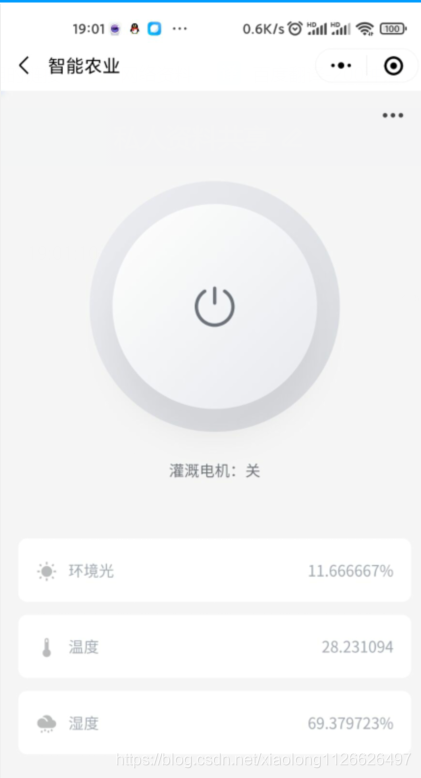
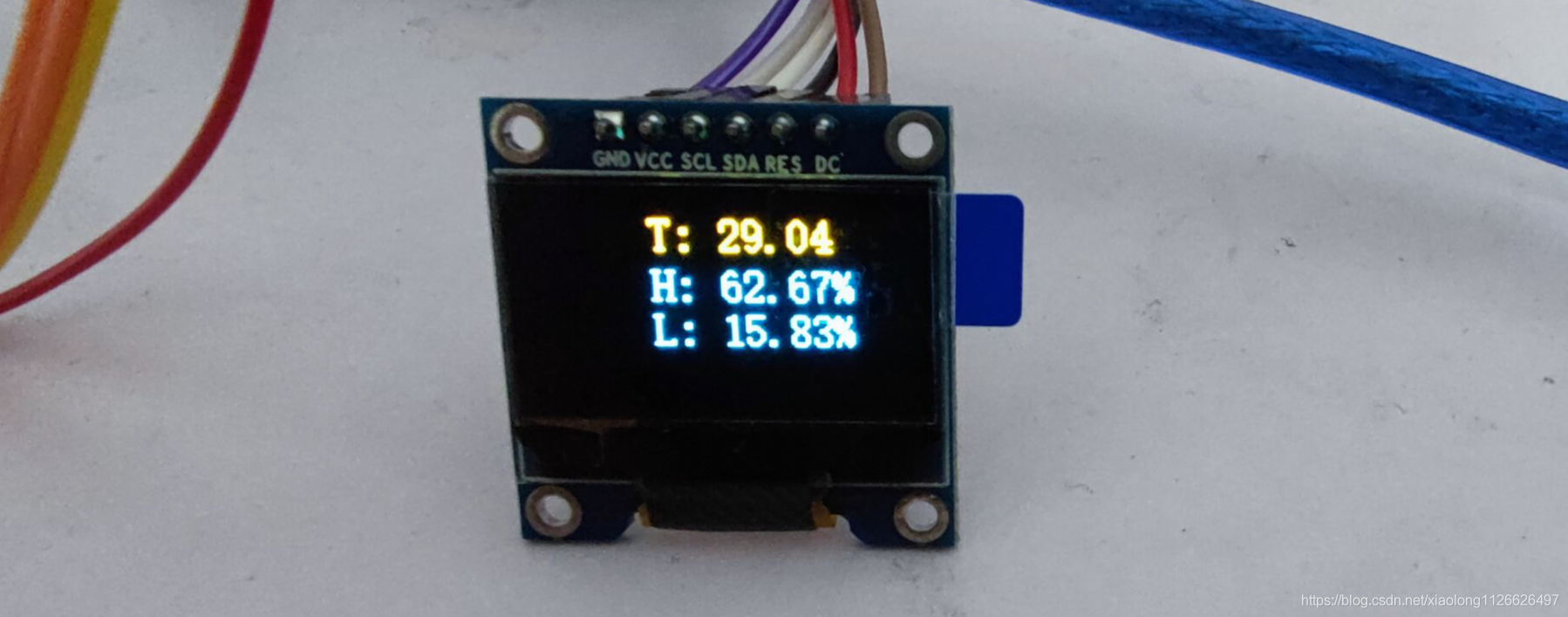
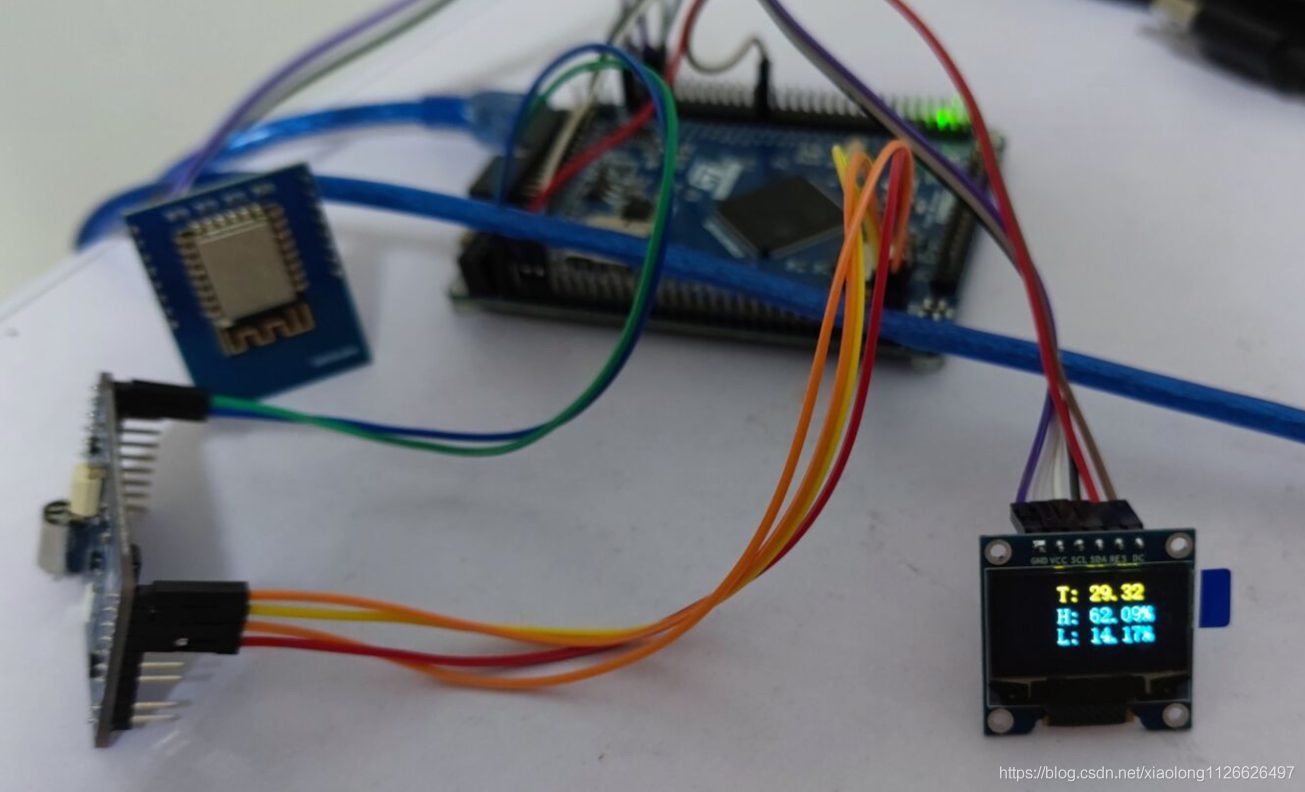
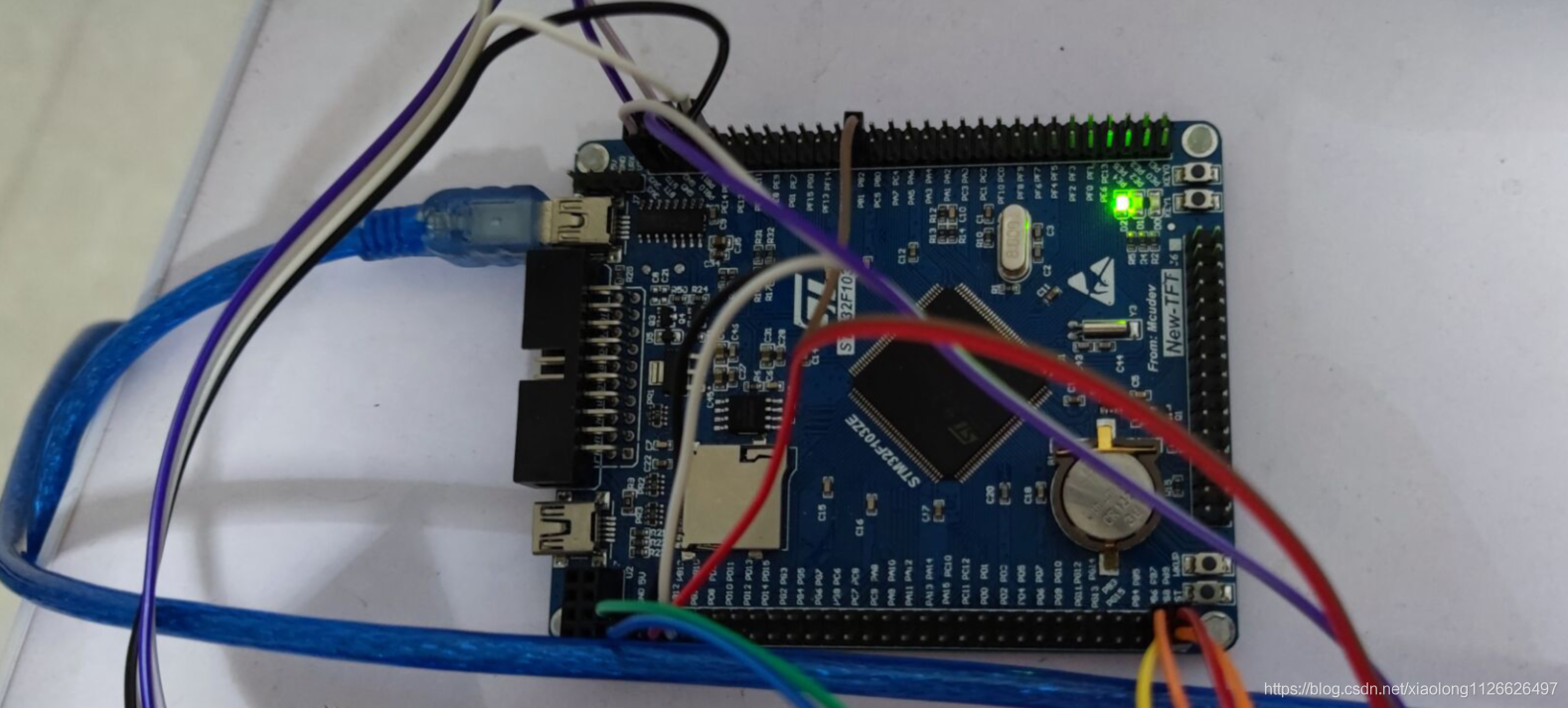

2, Introduction to smart agriculture
Smart agriculture is to apply Internet of things technology to traditional agriculture, use sensors and software to control agricultural production through mobile platform or computer platform, so as to make traditional agriculture more "smart". In addition to precise perception, control and decision-making management, in a broad sense, smart agriculture also includes agricultural e-commerce, food traceability and anti-counterfeiting, agricultural leisure tourism, agricultural information services, etc. The so-called "smart agriculture" is to make full use of the achievements of modern information technology, integrate and apply computer and network technology, Internet of things technology, audio and video technology, 3S technology, wireless communication technology and expert wisdom and knowledge, and realize intelligent management such as agricultural visual remote diagnosis, remote control and disaster early warning.
Smart agriculture is an advanced stage of agricultural production. It integrates emerging Internet, mobile Internet, cloud computing and Internet of things technologies, and relies on various sensor nodes (environmental temperature and humidity, soil moisture, carbon dioxide, image, etc.) and wireless communication networks deployed on the agricultural production site to realize the intelligent perception, intelligent early warning, intelligent decision-making of the agricultural production environment Intelligent analysis and expert online guidance provide precision planting, visual management and intelligent decision-making for agricultural production. "Smart agriculture" is a comprehensive and comprehensive application of cloud computing, sensor network, 3S and other information technologies in agriculture to achieve more complete information-based support, more thorough agricultural information perception, more centralized data resources, wider interconnection, deeper intelligent control and more intimate public services. The integration of "smart agriculture" with modern biotechnology, planting technology and other science and technology is of great significance to the construction of world-class agriculture.
The project uses STM32F103ZET6 + ESP8266 to design an intelligent agricultural management system, which can obtain the temperature and humidity data and illumination data in the air, and judge whether to carry out irrigation according to the air temperature and humidity data in the planting area; The collected temperature, humidity and illumination can be uploaded to Tencent cloud Internet of things platform through ESP8266 + MQTT protocol and pushed to wechat applet for real-time viewing; The motor pumping irrigation can be directly controlled on the applet.
Hardware details:
Main control MCU: stm32f103zet6
Ambient light sensor: BH1750
Temperature and humidity sensor: SHT30
Local OLED display: zhongjingyuan electronics 0.96-inch SPI interface OLED display
Motor: micro DC motor
3, Create Tencent cloud Internet of things platform equipment and configure wechat applet
If you have never used Tencent cloud Internet of things platform before, please see the detailed steps of creation here: https://blog.csdn.net/xiaolong1126626497/article/details/116902653
The following are the key steps to log in to Tencent cloud Internet of things platform and create a smart agriculture device. Some details are not written. Please see the link above for details.
Official website address: https://console.cloud.tencent.com/iotexplorer
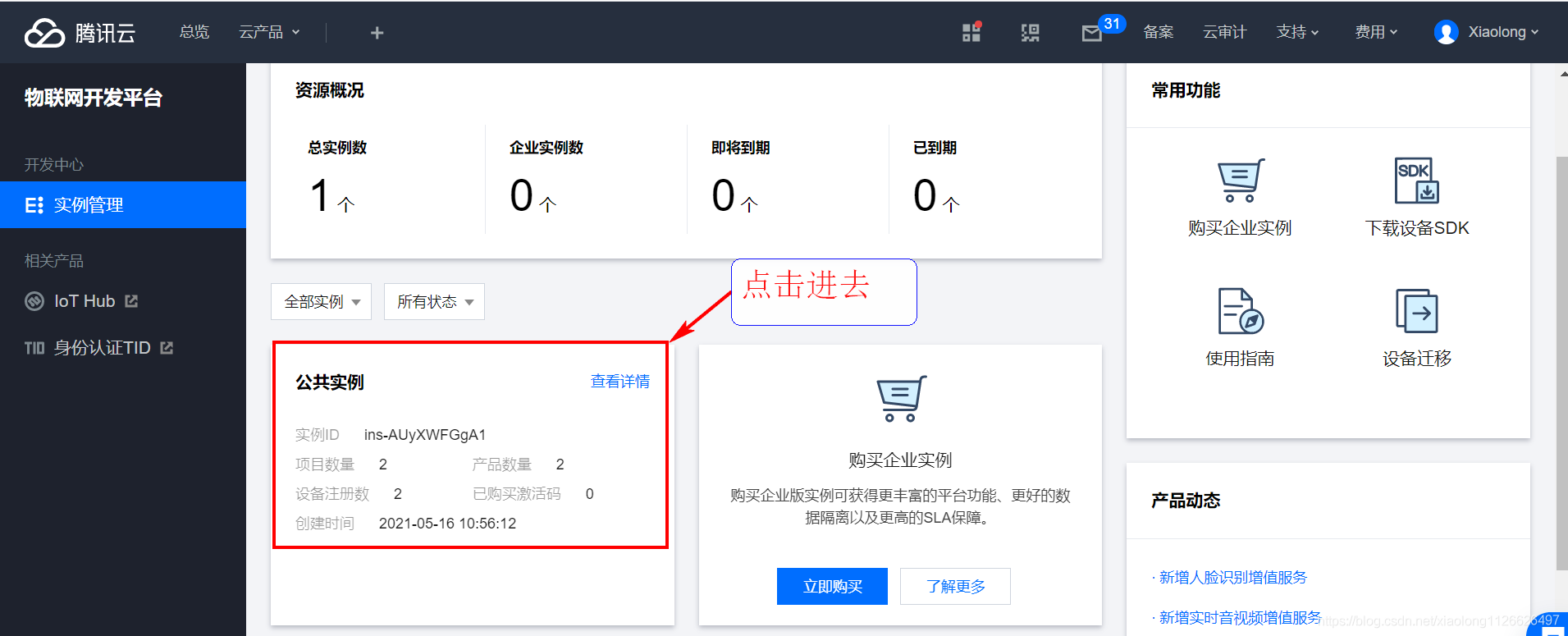
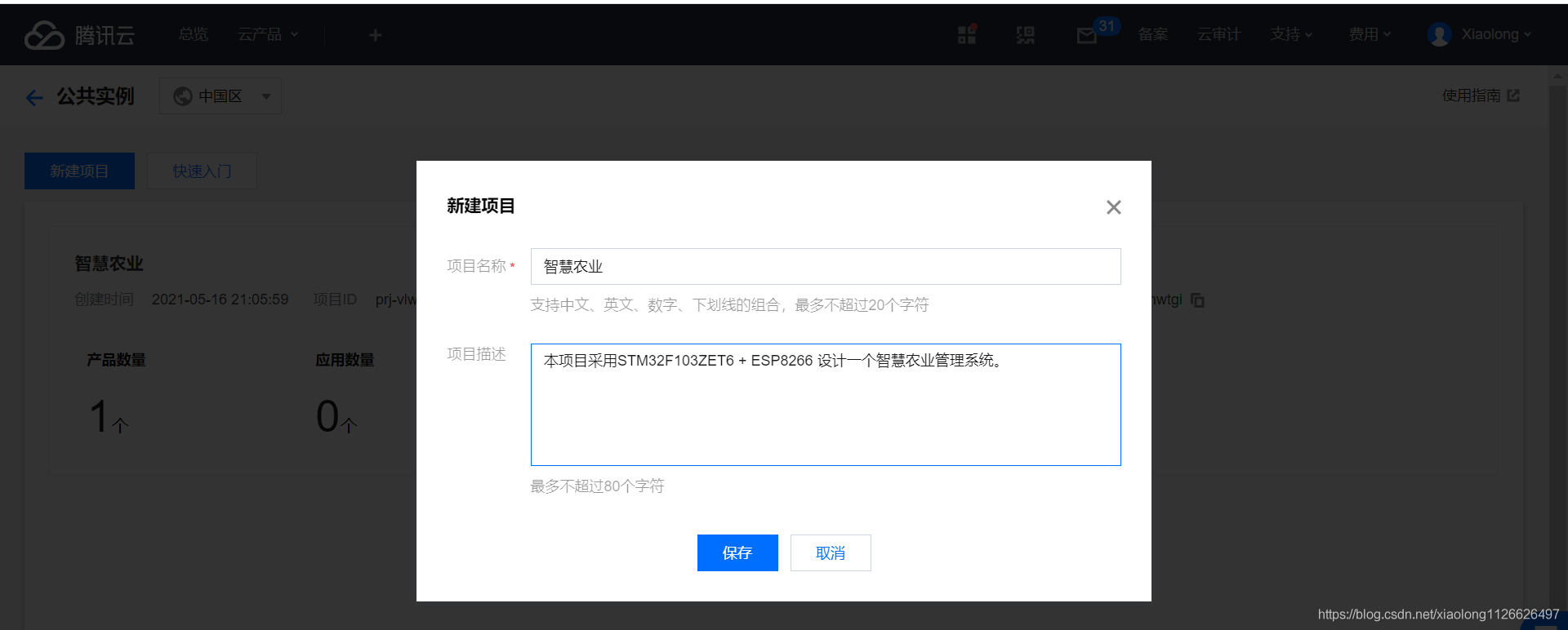
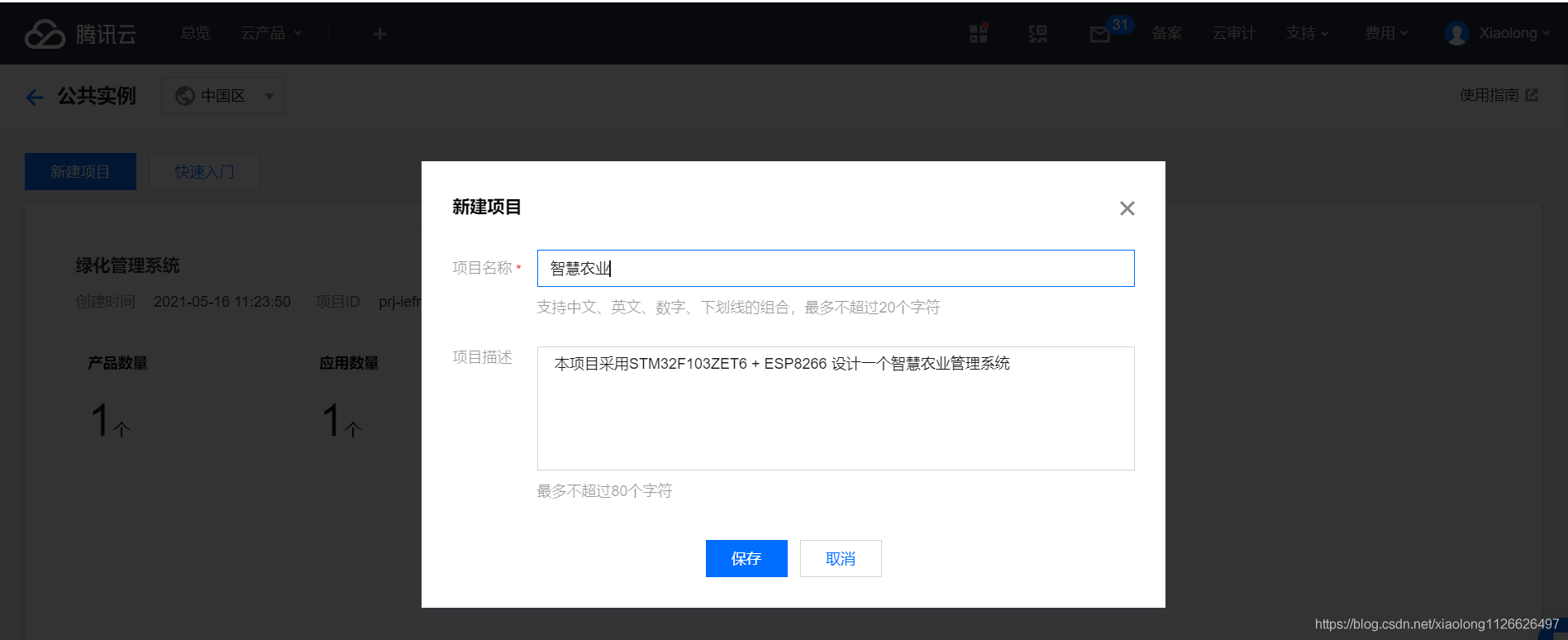

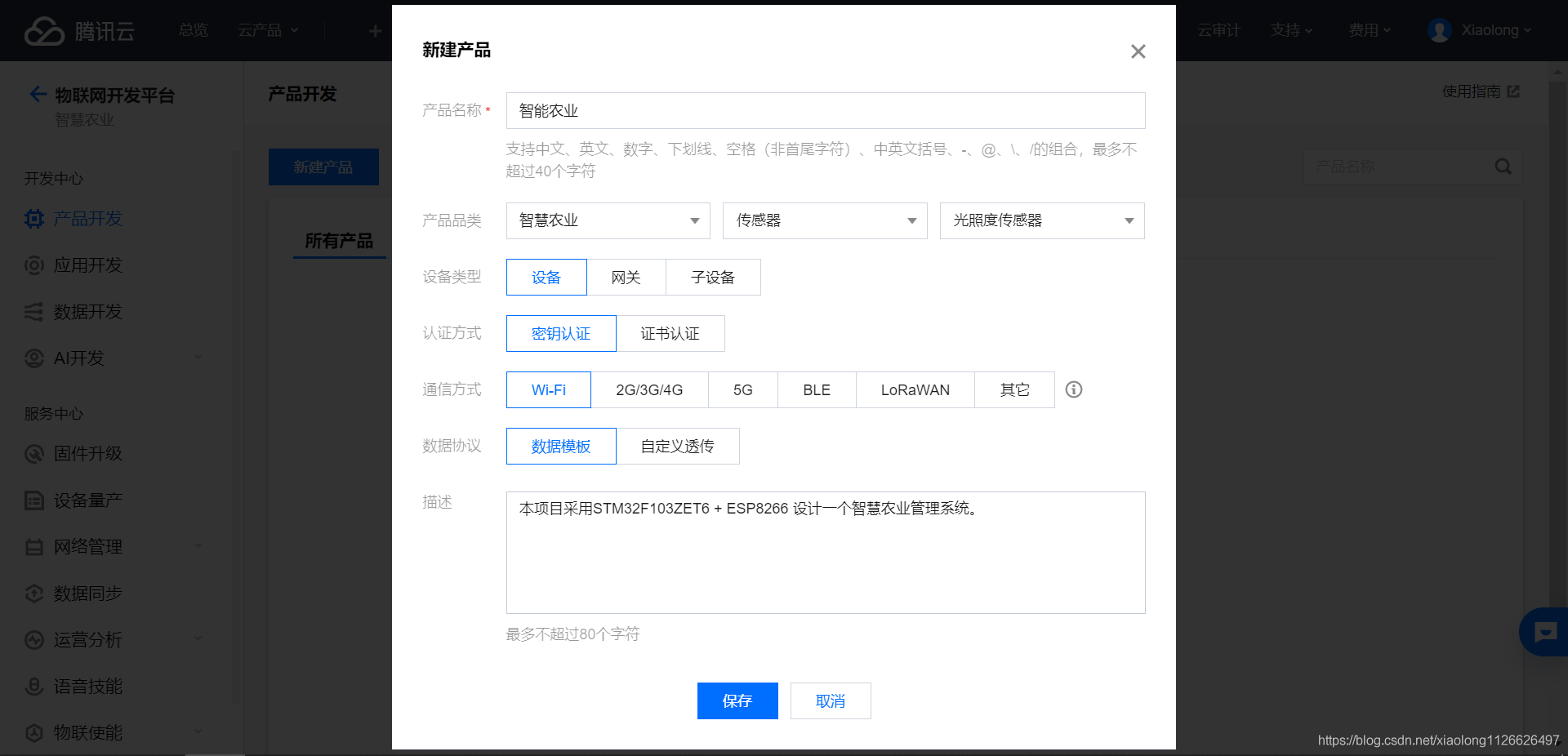

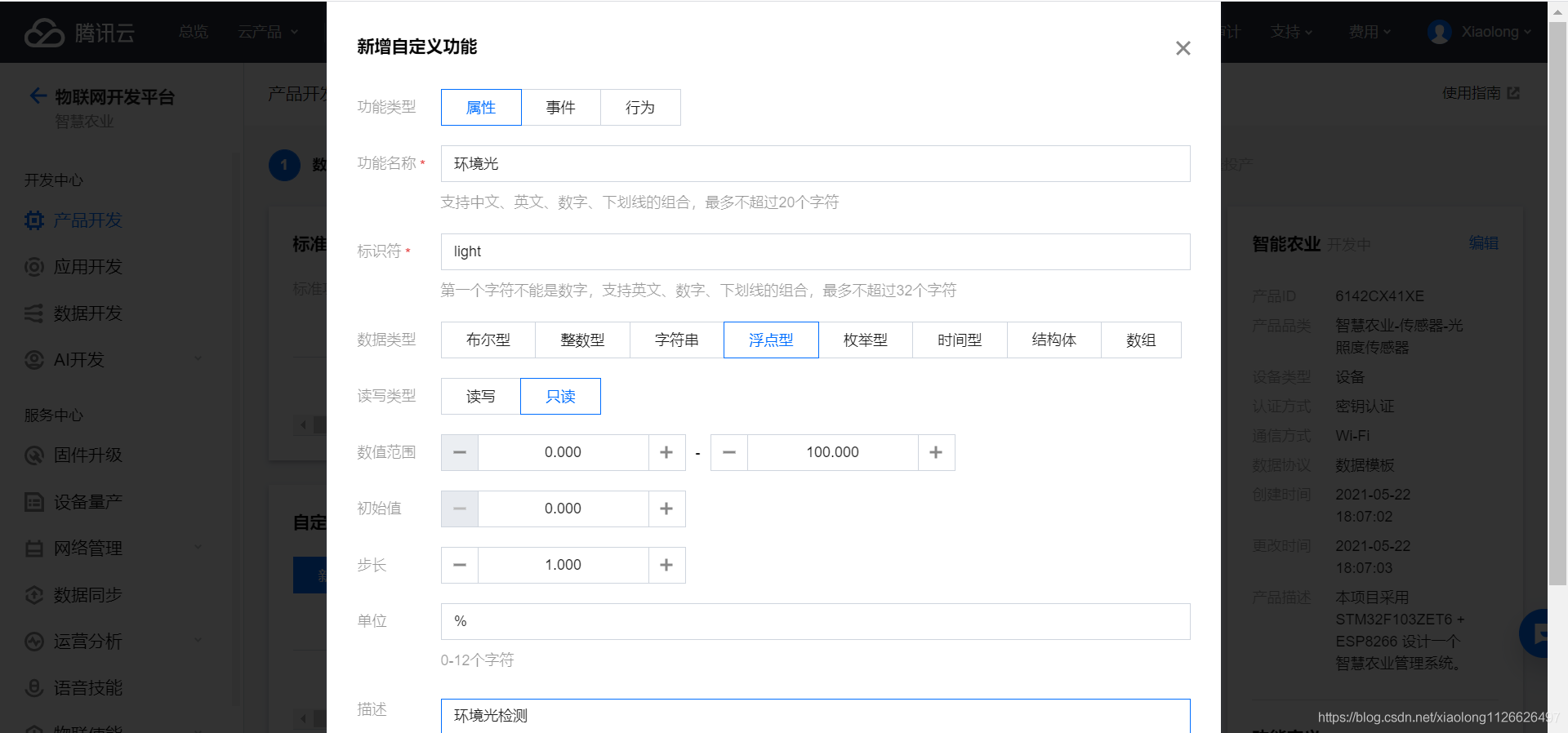
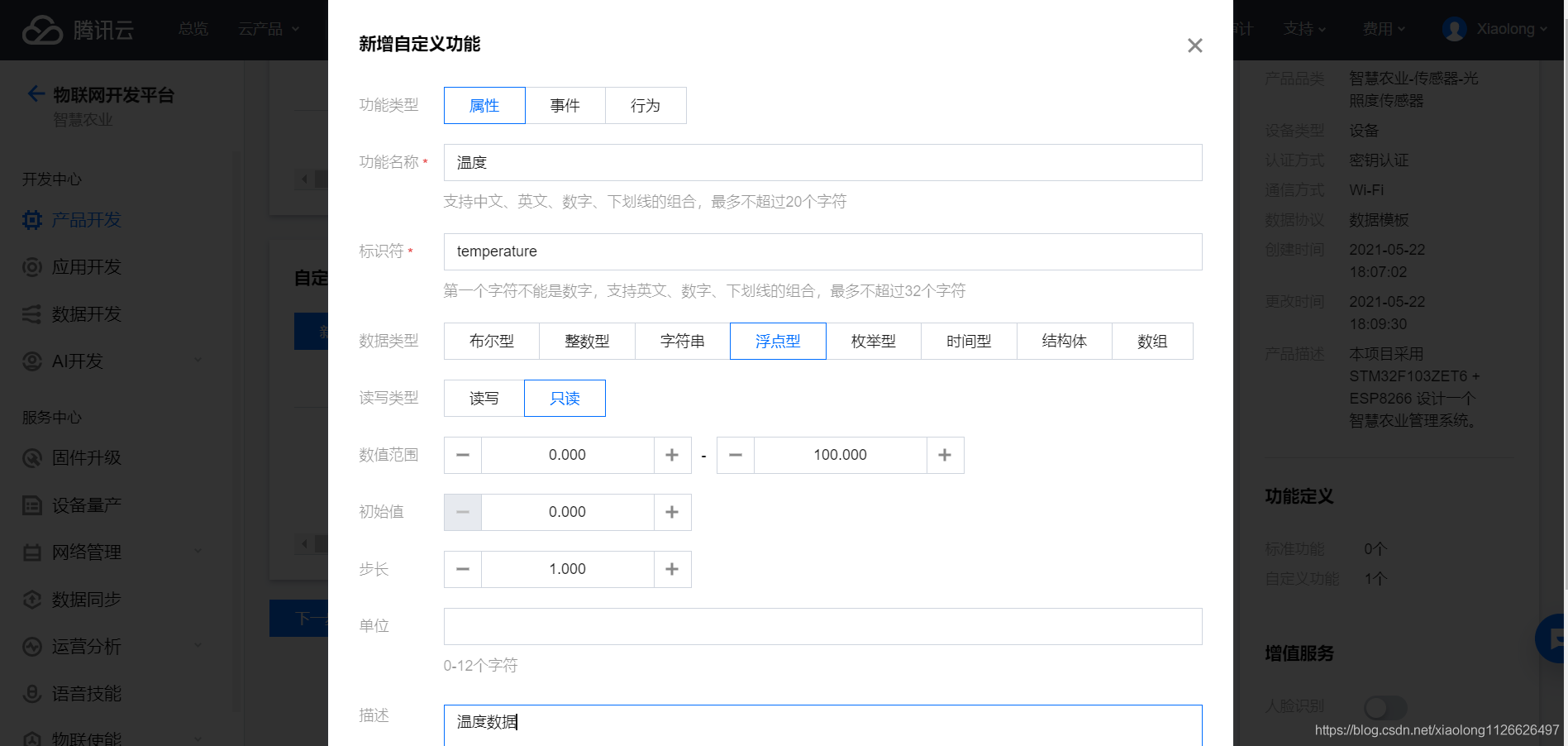

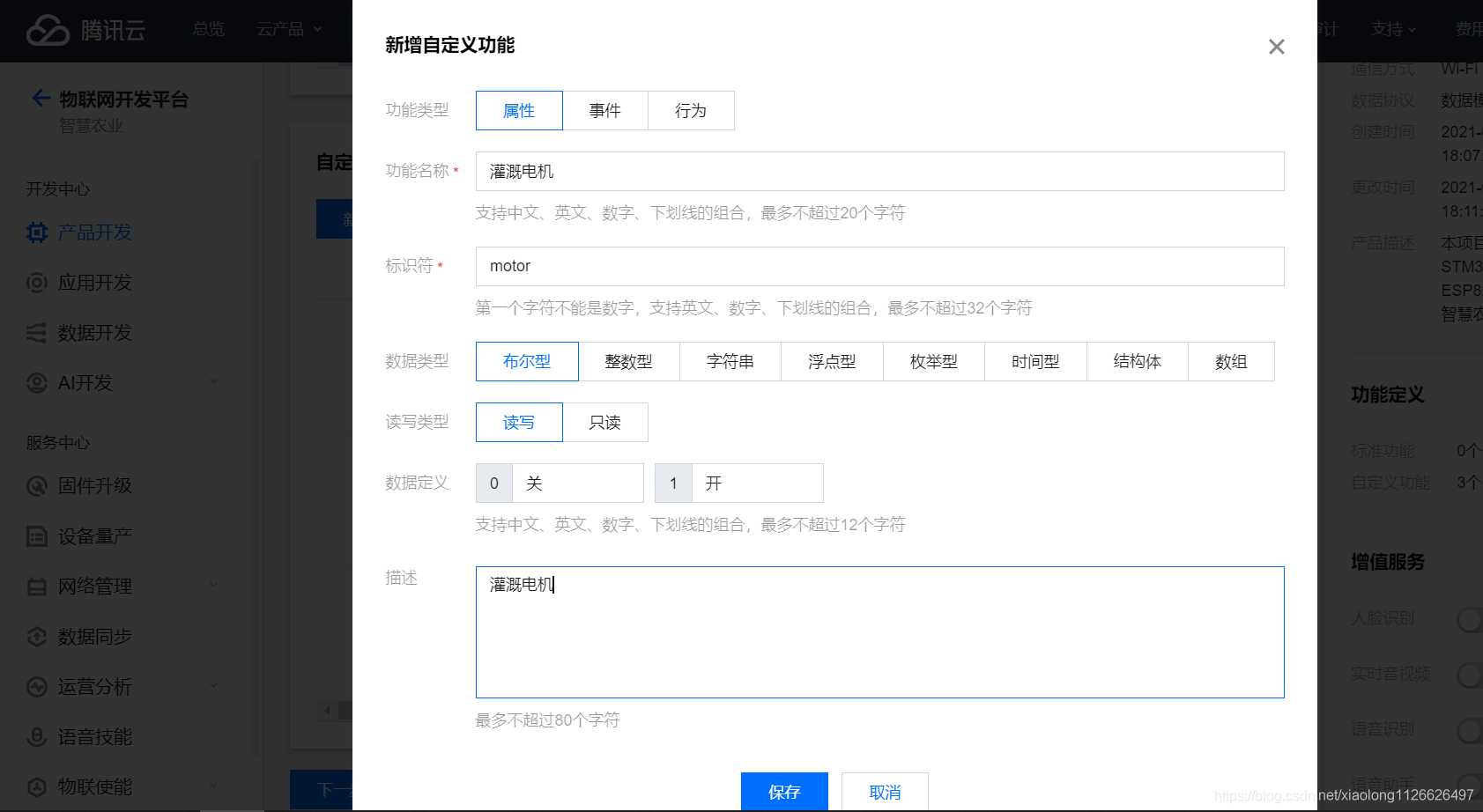

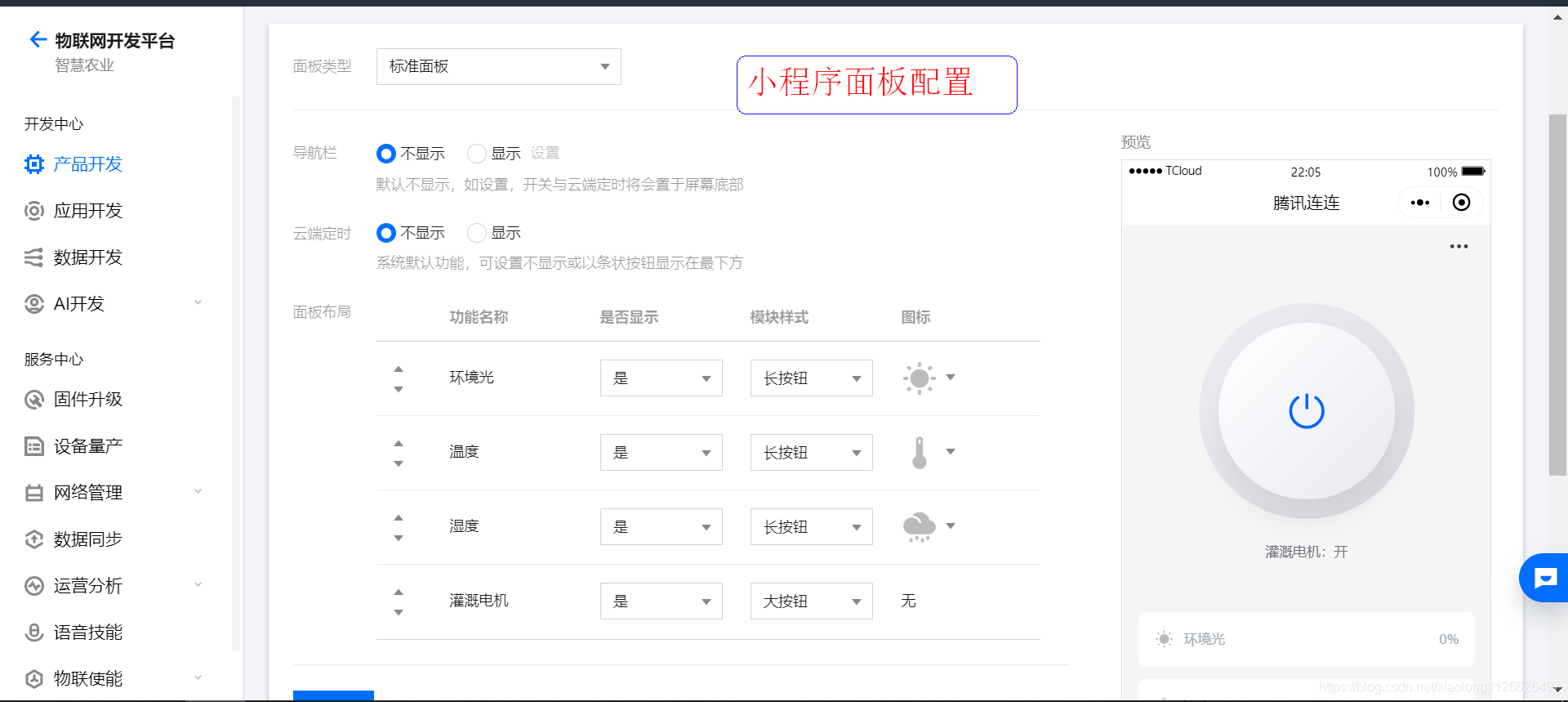

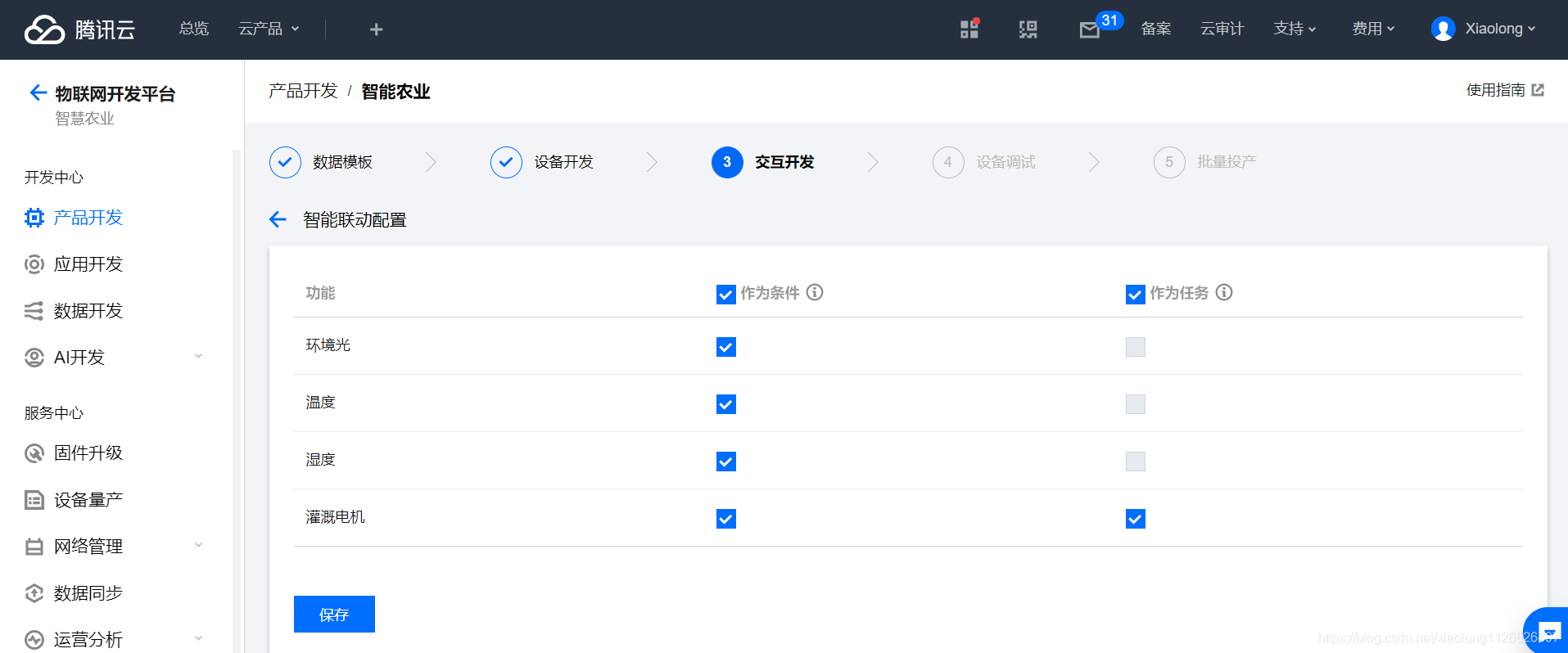
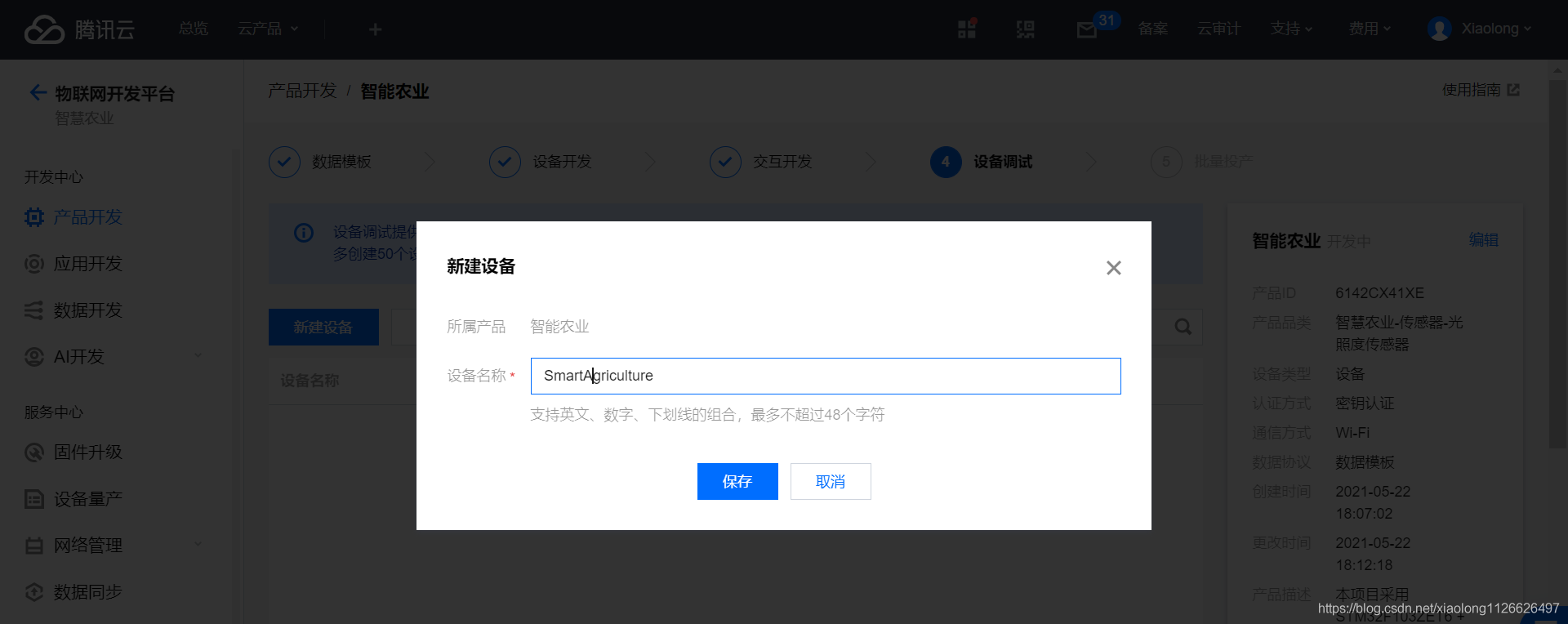
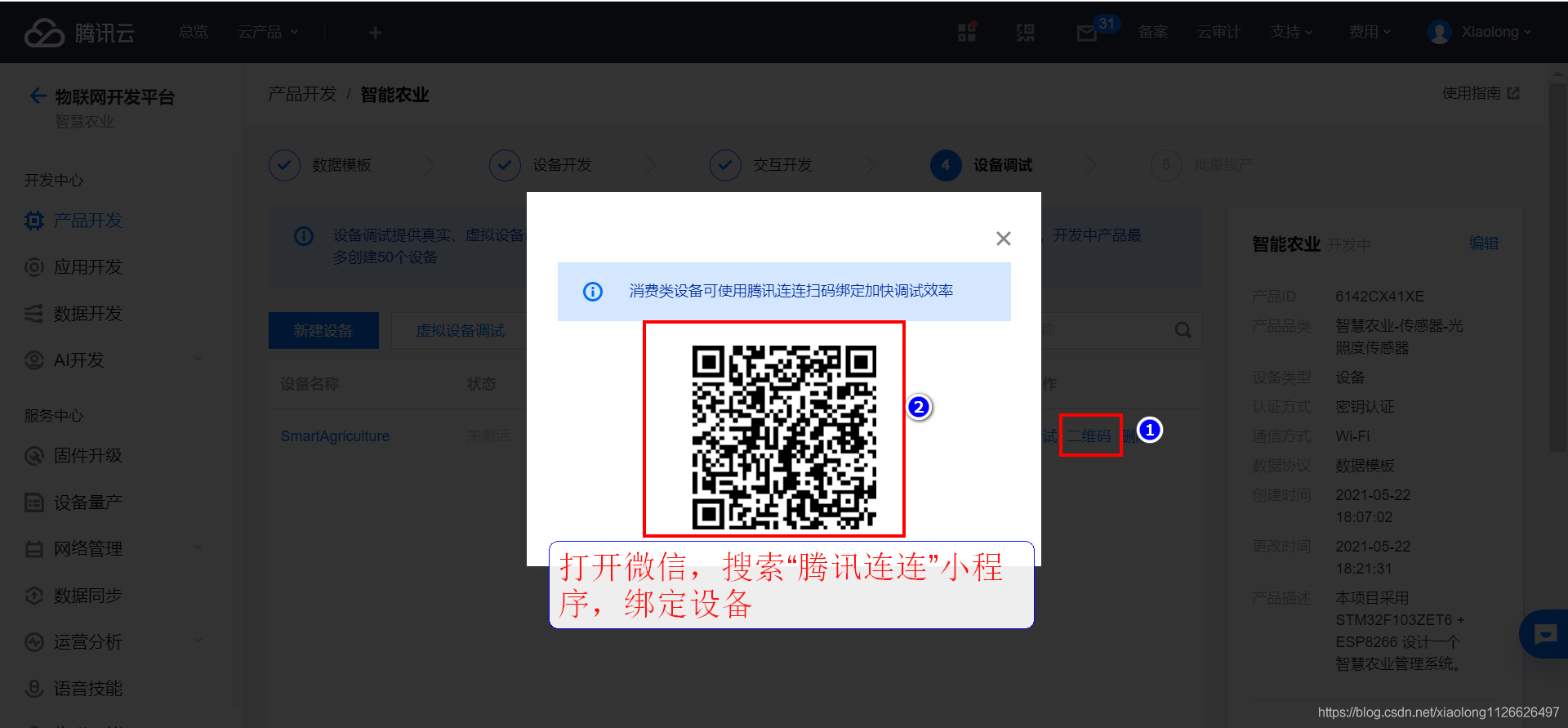
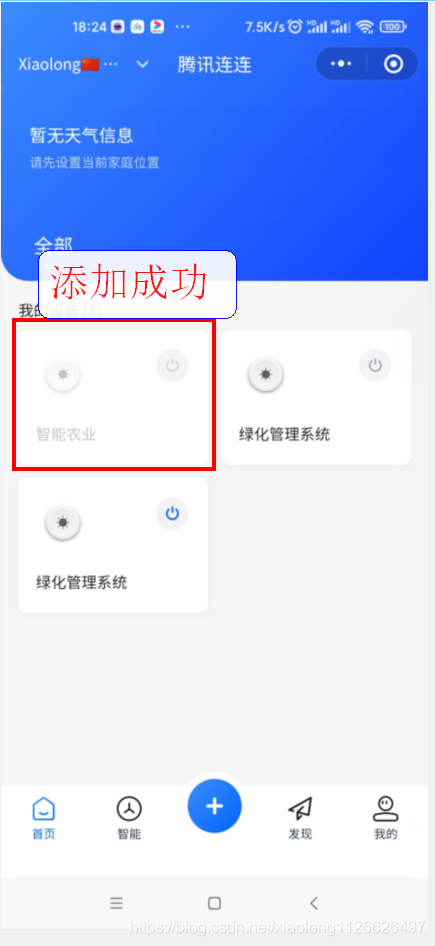
4, Generate the device login information of Tencent Internet of things platform
Logging in using MQTT protocol requires some parameter information, which needs to be generated in the way provided on the official website.
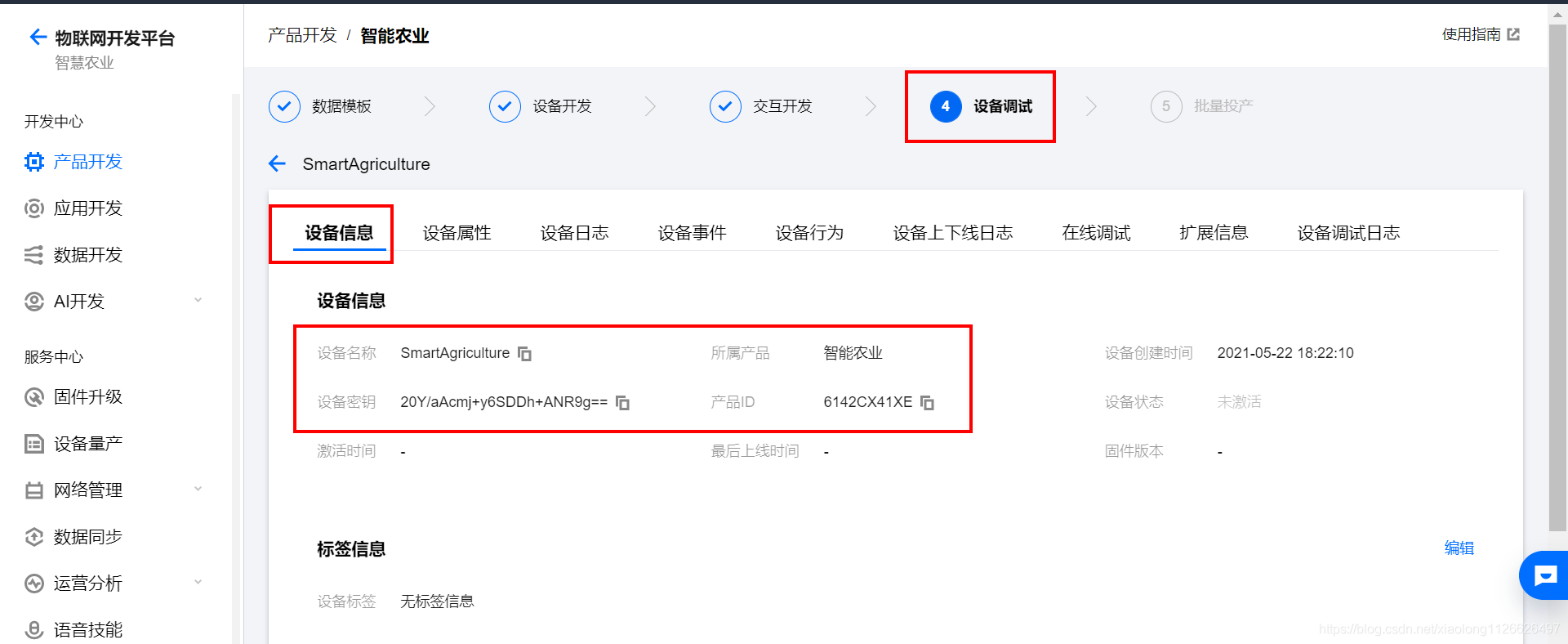
Python sample code:
#!/usr/bin/python
# -*- coding: UTF-8 -*-
import base64
import hashlib
import hmac
import random
import string
import time
import sys
# Generates a random string of the specified length
def RandomConnid(length):
return ''.join(random.choice(string.ascii_uppercase + string.digits) for _ in range(length))
# Generate parameters required for accessing the Internet of things communication platform
def IotHmac(productID, devicename, devicePsk):
# 1. Generate connid as a random string to facilitate background positioning
connid = RandomConnid(5)
# 2. Generate expiration time, which represents the expiration time of the signature. It is a UTF8 string in seconds from 00:00:00 UTC time on January 1, 1970
expiry = int(time.time()) + 30*24*60 * 60
# 3. Generate the clientid part of MQTT in the format ${productid}${devicename}
clientid = "{}{}".format(productID, devicename)
# 4. Generate the username part of MQTT in the format of ${ClientID}$ {sdkappid};$ {connid};$ {expiry}
username = "{};12010126;{};{}".format(clientid, connid, expiry)
# 5. Sign the username and generate a token
secret_key = devicePsk.encode('utf-8') # convert to bytes
data_to_sign = username.encode('utf-8') # convert to bytes
secret_key = base64.b64decode(secret_key) # this is still bytes
token = hmac.new(secret_key, data_to_sign, digestmod=hashlib.sha256).hexdigest()
# 6. Generate the password field according to the rules of the Internet of things communication platform
password = "{};{}".format(token, "hmacsha256")
return {
"clientid" : clientid,
"username" : username,
"password" : password
}
if __name__ == '__main__':
# The parameters are filled in respectively: Product ID, equipment name and equipment key
print(IotHmac("6142CX41XE", "SmartAgriculture","20Y/aAcmj+y6SDDh+ANR9g=="))The output login parameters are used for MQTT protocol parameters:
{'clientid': '6142CX41XESmartAgriculture', 'username': '6142CX41XESmartAgriculture;12010126;HUA2G;1624271589',
'password': 'a8aadebe9721f70e6f9e14fe56ff1d2b5cac9625fa1f96af2f0e0098597fe78b;hmacsha256'}5, Test with MQTT software
MQTT client software download address: https://download.csdn.net/download/xiaolong1126626497/18784012
The software is developed by QT. The source code address is: https://blog.csdn.net/xiaolong1126626497/article/details/116779490
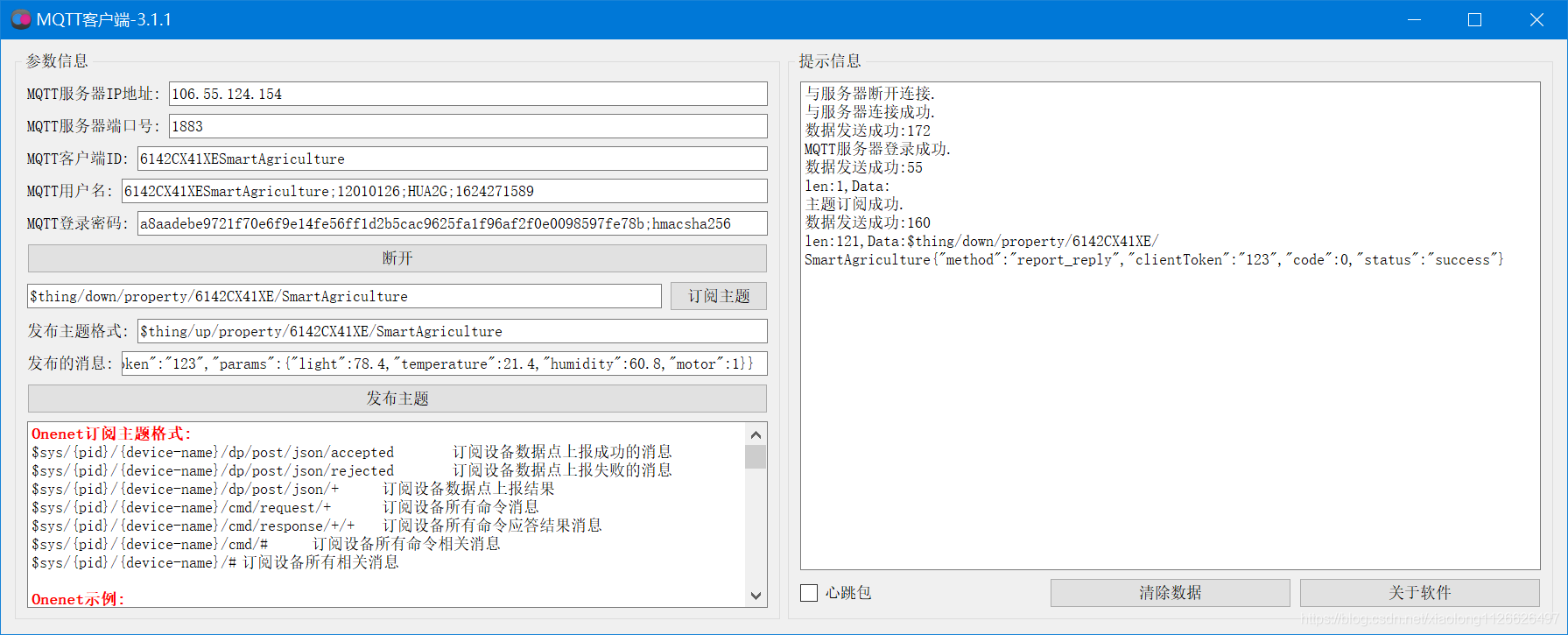
Format of equipment theme publishing and definition:
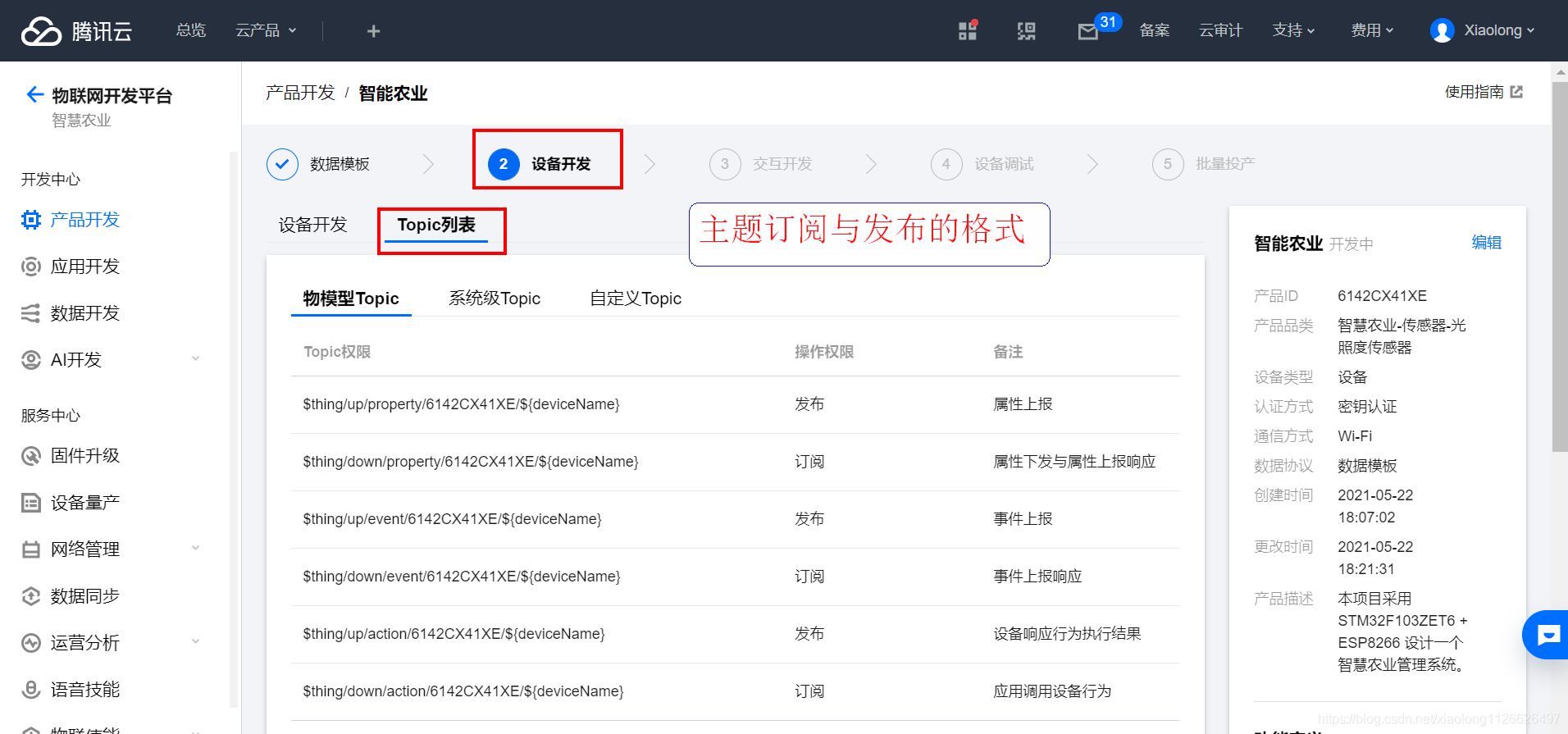
Device message data upload format:
{"method":"report","clientToken":"123","params":{"light":78.4,"temperature":21.4,"humidity":60.8,"motor":1}}After successful login, you can see that the device is online:

Open wechat applet to view the data uploaded by the device:
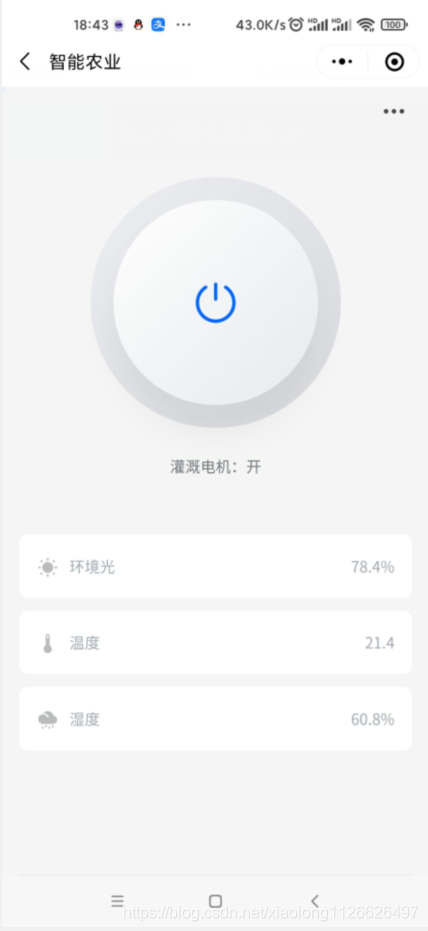
6, Write STM32 device side code
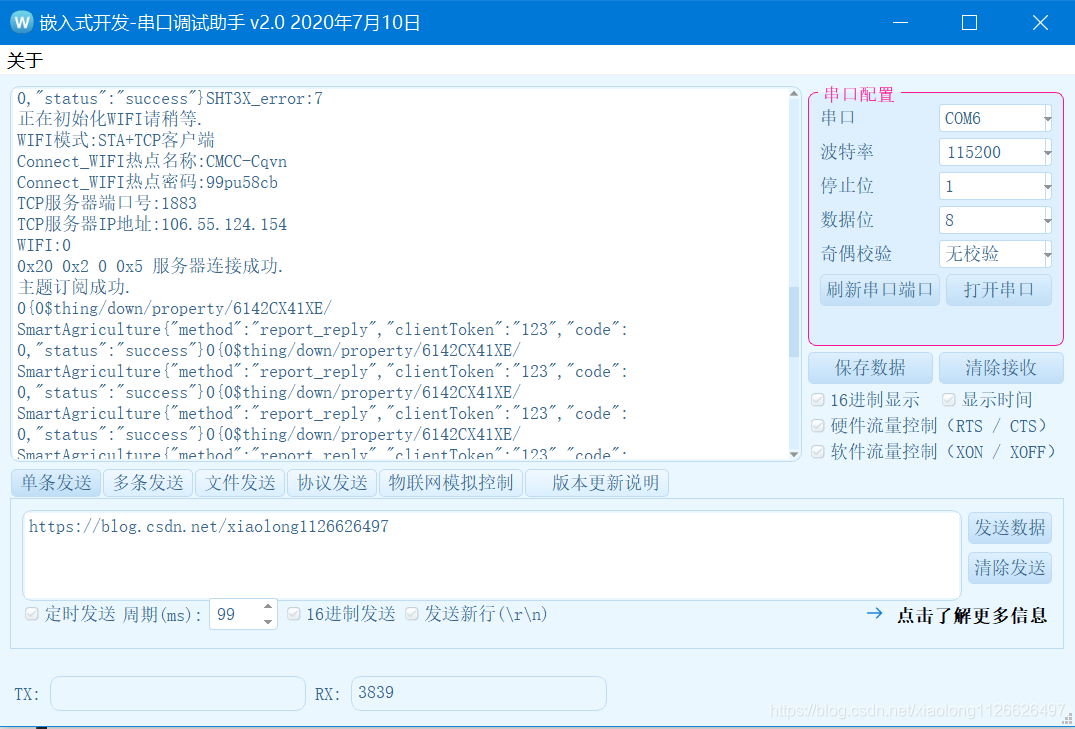
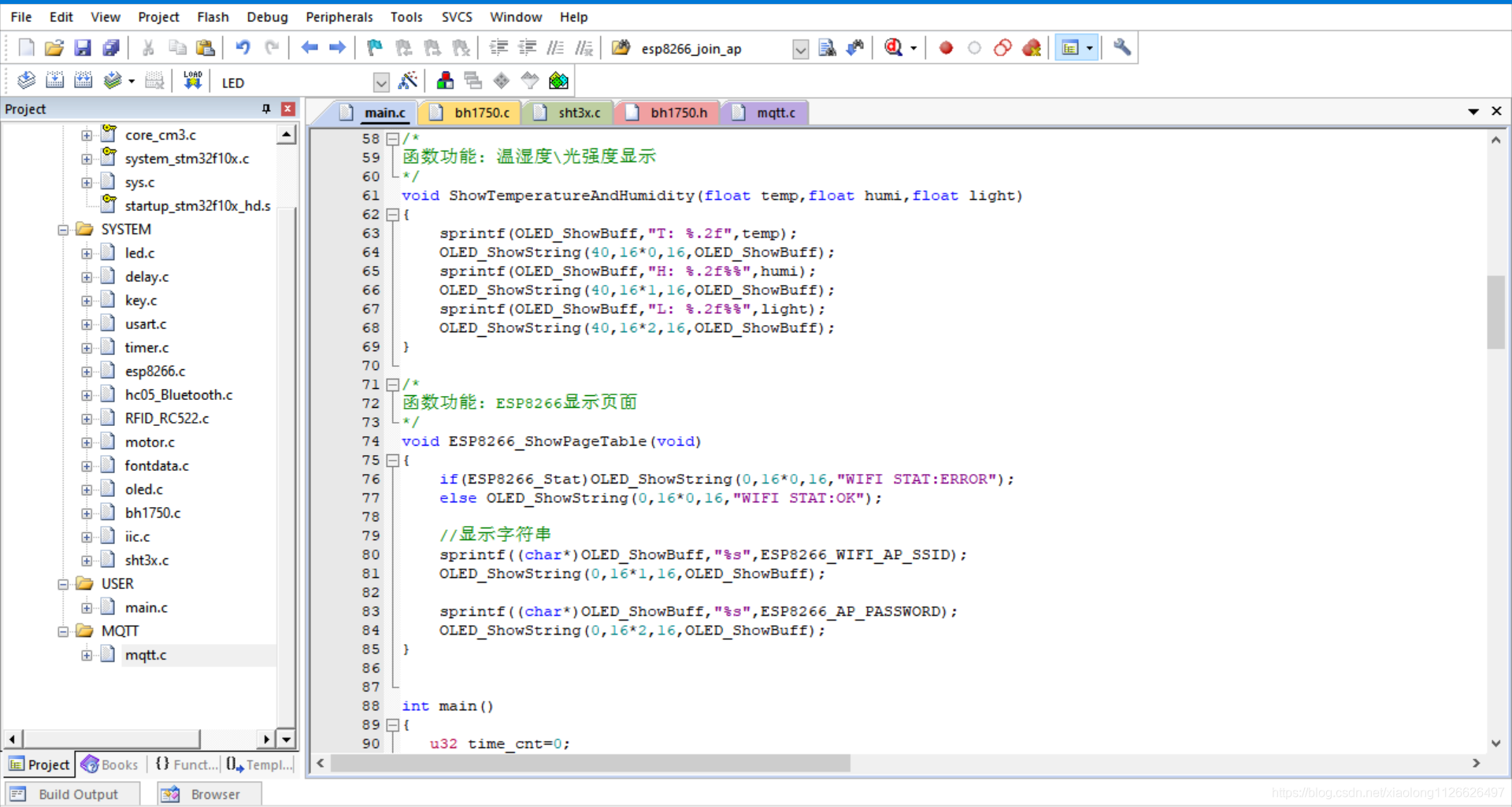
6.1 main.c code
#include "stm32f10x.h"
#include "led.h"
#include "delay.h"
#include "key.h"
#include "usart.h"
#include <string.h>
#include "timer.h"
#include "esp8266.h"
#include "mqtt.h"
#include "oled.h"
#include "fontdata.h"
#include "bh1750.h"
#include "iic.h"
#include "sht3x.h"
/*
Hardware connection mode:
ESP8266 The serial WIFI module is connected with serial port 3 of STM32.
PB10--RXD Module receiving pin
PB11--TXD Module sending pin
GND---GND land
VCC---VCC Power supply (3.3V~5.0V)
OLED Wiring:
D0----SCK-----PB14
D1----MOSI----PB13
RES—Reset (active low) - PB12
DC---Data and command control pin - PB1
CS---Chip selection pin ----- PA7
Micro DC motor: PB8
Purple light: PB9
LED Hardware connection: PB5 PE5
KEY Hardware connection: PE3 PE4
*/
#define ESP8266_ WIFI_ AP_ SSID "CMCC cqvn" / / the name of the router to be connected -- do not appear Chinese, spaces and other special characters
#define ESP8266_AP_PASSWORD "99pu58cb" / / password of the router to be connected
//Equipment information of Tencent Internet of things server
#define MQTT_ClientID "6142CX41XESmartAgriculture"
#define MQTT_UserName "6142CX41XESmartAgriculture;12010126;HUA2G;1624271589"
#define MQTT_PassWord "a8aadebe9721f70e6f9e14fe56ff1d2b5cac9625fa1f96af2f0e0098597fe78b;hmacsha256"
//Topics for subscriptions and publications
#define SET_ Topic "$thing / down / property / 6142cx41xe / smartagriculture" / / subscription
#define POST_TOPIC "$thing/up/property/6142CX41XE/SmartAgriculture" / / release
char mqtt_message[200];//Report data buffer
char OLED_ShowBuff[100];
u8 ESP8266_Stat=0;
/*
Function: temperature and humidity \ light intensity display
*/
void ShowTemperatureAndHumidity(float temp,float humi,float light)
{
sprintf(OLED_ShowBuff,"T: %.2f",temp);
OLED_ShowString(40,16*0,16,OLED_ShowBuff);
sprintf(OLED_ShowBuff,"H: %.2f%%",humi);
OLED_ShowString(40,16*1,16,OLED_ShowBuff);
sprintf(OLED_ShowBuff,"L: %.2f%%",light);
OLED_ShowString(40,16*2,16,OLED_ShowBuff);
}
/*
Function function: ESP8266 display page
*/
void ESP8266_ShowPageTable(void)
{
if(ESP8266_Stat)OLED_ShowString(0,16*0,16,"WIFI STAT:ERROR");
else OLED_ShowString(0,16*0,16,"WIFI STAT:OK");
//display string
sprintf((char*)OLED_ShowBuff,"%s",ESP8266_WIFI_AP_SSID);
OLED_ShowString(0,16*1,16,OLED_ShowBuff);
sprintf((char*)OLED_ShowBuff,"%s",ESP8266_AP_PASSWORD);
OLED_ShowString(0,16*2,16,OLED_ShowBuff);
}
int main()
{
u32 time_cnt=0;
u32 i;
u8 key;
u8 page=0;
float temp=0;
float humi=0;
float light=0;
u8 motor_state=0;
float Humidity;
float Temperature;
delay_ms(1000);
delay_ms(1000);
LED_Init();
KEY_Init();
IIC_Init();
//OLED initialization
OLED_Init(0xc8,0xa1); //OLED display initialization - normal display;
//Clear screen
OLED_Clear(0);
USART1_Init(115200);
TIMER1_Init(72,20000); //Timeout 20ms
USART3_Init(115200);//Serial WIFI
TIMER3_Init(72,20000); //Timeout 20ms
Init_SHT30();
USART1_Printf("Initializing WIFI One moment please.\n");
if(ESP8266_Init())
{
ESP8266_Stat=1;
USART1_Printf("ESP8266 Hardware detection error.\n");
}
else
{
//Unencrypted port
USART1_Printf("WIFI:%d\n",ESP8266_STA_TCP_Client_Mode(ESP8266_WIFI_AP_SSID,ESP8266_AP_PASSWORD,"106.55.124.154",1883,1));
}
//2. MQTT protocol initialization
MQTT_Init();
//3. Connect to Tencent cloud IOT server
while(MQTT_Connect(MQTT_ClientID,MQTT_UserName,MQTT_PassWord))
{
USART1_Printf("Server connection failed,Retrying...\n");
delay_ms(500);
}
USART1_Printf("Server connection succeeded.\n");
//3. Subscribe to topics
if(MQTT_SubscribeTopic(SET_TOPIC,0,1))
{
USART1_Printf("Topic subscription failed.\n");
}
else
{
USART1_Printf("Topic subscription succeeded.\n");
}
while(1)
{
//Press the key to test unlocking and locking
key=KEY_Scan(0);
if(key==1)
{
//Clear screen
OLED_Clear(0);
//Turn pages
if(page>=1)
{
page=0;
}
else
{
page++;
}
LED1=!LED1; //LEd status light
}
else if(key==2)
{
LED1=!LED1; //LEd status light
time_cnt=0;
//Motor status change
MOTOR_DEV=!MOTOR_DEV;
//Motor status
motor_state=MOTOR_DEV;
//fill-in light
LIGHT_DEV=!LIGHT_DEV;
}
//Unlocking mode of wechat applet: receive the data returned by WIFI
if(USART3_RX_FLAG)
{
USART3_RX_BUFFER[USART3_RX_CNT]='\0';
//Print the data returned by wechat applet to the serial port
for(i=0;i<USART3_RX_CNT;i++)
{
USART1_Printf("%c",USART3_RX_BUFFER[i]);
}
//If the attribute is issued, judge whether to unlock or close the lock
if(USART3_RX_CNT>5)
{
//Use string lookup function
if(strstr((char*)&USART3_RX_BUFFER[5],"\"motor\":1"))
{
LED1=0; //Light up
MOTOR_DEV=1; //Turn on the motor
motor_state=1;
}
else if(strstr((char*)&USART3_RX_BUFFER[5],"\"motor\":0"))
{
LED1=1; //Lights out
MOTOR_DEV=0; //Turn off the motor
motor_state=0;
}
}
USART3_RX_CNT=0;
USART3_RX_FLAG=0;
}
//Timing and keeping synchronization with wechat applet -- once a second
delay_ms(10);
time_cnt++;
if(time_cnt==50)
{
time_cnt=0;
//Status light -- indicates that the program is still alive
LED2=!LED2;
//Read light intensity
light=Read_BH1750_Data();
//Read temperature and humidity
SHT3x_ReadData(&Humidity,&Temperature);
humi=Humidity;
temp=Temperature;
//Upload data
sprintf(mqtt_message,"{\"method\":\"report\",\"clientToken\":\"123\",\"params\":{\"temperature\":%f,\"humidity\":%f,\"motor\":%d,\"light\":%f}}",
temp,humi,motor_state,light);
MQTT_PublishData(POST_TOPIC,mqtt_message,0);
//Automatic irrigation according to humidity
if(humi<50.0) //Less than 50 automatic irrigation
{
motor_state=1; //Motor status update
MOTOR_DEV=1; //Turn on the motor
}
}
//OLED display
if(page==0)
{
ShowTemperatureAndHumidity(temp,humi,light);
}
else if(page==1)
{
ESP8266_ShowPageTable();
}
}
}6.2 mqtt.c code
#include "mqtt.h"
u8 *mqtt_rxbuf;
u8 *mqtt_txbuf;
u16 mqtt_rxlen;
u16 mqtt_txlen;
u8 _mqtt_txbuf[256];//Send data buffer
u8 _mqtt_rxbuf[256];//Receive data buffer
typedef enum
{
//name Value Message flow direction describe
M_RESERVED1 =0 , // prohibit retain
M_CONNECT , // Client to server The client requests to connect to the server
M_CONNACK , // Server to client Connection message confirmation
M_PUBLISH , // Both directions are allowed Release news
M_PUBACK , // Both directions are allowed QoS 1 message publishing receipt confirmation
M_PUBREC , // Both directions are allowed Release received (first step of guaranteed delivery)
M_PUBREL , // Both directions are allowed Release release (the second step of guaranteed delivery)
M_PUBCOMP , // Both directions are allowed QoS 2 message publishing is completed (the third step of ensuring interaction)
M_SUBSCRIBE , // Client to server Client subscription request
M_SUBACK , // Server to client Subscription request message confirmation
M_UNSUBSCRIBE , // Client to server Client unsubscribe request
M_UNSUBACK , // Server to client Unsubscribe message confirmation
M_PINGREQ , // Client to server Heartbeat request
M_PINGRESP , // Server to client Heartbeat response
M_DISCONNECT , // Client to server Client disconnect
M_RESERVED2 , // prohibit retain
}_typdef_mqtt_message;
//Connection succeeded. The server responded 20 02 00 00
//Client actively disconnects e0 00
const u8 parket_connetAck[] = {0x20,0x02,0x00,0x00};
const u8 parket_disconnet[] = {0xe0,0x00};
const u8 parket_heart[] = {0xc0,0x00};
const u8 parket_heart_reply[] = {0xc0,0x00};
const u8 parket_subAck[] = {0x90,0x03};
void MQTT_Init(void)
{
//Buffer assignment
mqtt_rxbuf = _mqtt_rxbuf;
mqtt_rxlen = sizeof(_mqtt_rxbuf);
mqtt_txbuf = _mqtt_txbuf;
mqtt_txlen = sizeof(_mqtt_txbuf);
memset(mqtt_rxbuf,0,mqtt_rxlen);
memset(mqtt_txbuf,0,mqtt_txlen);
//Unconditional active disconnection
MQTT_Disconnect();
delay_ms(100);
MQTT_Disconnect();
delay_ms(100);
}
/*
Function function: login server
Function return value: 0 means success, 1 means failure
*/
u8 MQTT_Connect(char *ClientID,char *Username,char *Password)
{
u8 i,j;
int ClientIDLen = strlen(ClientID);
int UsernameLen = strlen(Username);
int PasswordLen = strlen(Password);
int DataLen;
mqtt_txlen=0;
//Variable header + Payload each field contains a two byte length identifier
DataLen = 10 + (ClientIDLen+2) + (UsernameLen+2) + (PasswordLen+2);
//Fixed header
//Control message type
mqtt_txbuf[mqtt_txlen++] = 0x10; //MQTT Message Type CONNECT
//Remaining length (excluding fixed head)
do
{
u8 encodedByte = DataLen % 128;
DataLen = DataLen / 128;
// if there are more data to encode, set the top bit of this byte
if ( DataLen > 0 )
encodedByte = encodedByte | 128;
mqtt_txbuf[mqtt_txlen++] = encodedByte;
}while ( DataLen > 0 );
//Variable header
//Protocol name
mqtt_txbuf[mqtt_txlen++] = 0; // Protocol Name Length MSB
mqtt_txbuf[mqtt_txlen++] = 4; // Protocol Name Length LSB
mqtt_txbuf[mqtt_txlen++] = 'M'; // ASCII Code for M
mqtt_txbuf[mqtt_txlen++] = 'Q'; // ASCII Code for Q
mqtt_txbuf[mqtt_txlen++] = 'T'; // ASCII Code for T
mqtt_txbuf[mqtt_txlen++] = 'T'; // ASCII Code for T
//Protocol level
mqtt_txbuf[mqtt_txlen++] = 4; // MQTT Protocol version = 4 for version 3.1.1 protocol, the value of the protocol level field is 4(0x04)
//Connection flag
mqtt_txbuf[mqtt_txlen++] = 0xc2; // conn flags
mqtt_txbuf[mqtt_txlen++] = 0; // Keep-alive Time Length MSB
mqtt_txbuf[mqtt_txlen++] = 100; // Keep alive time length LSB 100s heartbeat packet keep alive time
mqtt_txbuf[mqtt_txlen++] = BYTE1(ClientIDLen);// Client ID length MSB
mqtt_txbuf[mqtt_txlen++] = BYTE0(ClientIDLen);// Client ID length LSB
memcpy(&mqtt_txbuf[mqtt_txlen],ClientID,ClientIDLen);
mqtt_txlen += ClientIDLen;
if(UsernameLen > 0)
{
mqtt_txbuf[mqtt_txlen++] = BYTE1(UsernameLen); //username length MSB
mqtt_txbuf[mqtt_txlen++] = BYTE0(UsernameLen); //username length LSB
memcpy(&mqtt_txbuf[mqtt_txlen],Username,UsernameLen);
mqtt_txlen += UsernameLen;
}
if(PasswordLen > 0)
{
mqtt_txbuf[mqtt_txlen++] = BYTE1(PasswordLen); //password length MSB
mqtt_txbuf[mqtt_txlen++] = BYTE0(PasswordLen); //password length LSB
memcpy(&mqtt_txbuf[mqtt_txlen],Password,PasswordLen);
mqtt_txlen += PasswordLen;
}
memset(mqtt_rxbuf,0,mqtt_rxlen);
MQTT_SendBuf(mqtt_txbuf,mqtt_txlen);
for(j=0;j<10;j++)
{
delay_ms(50);
if(USART3_RX_FLAG)
{
memcpy((char *)mqtt_rxbuf,USART3_RX_BUFFER,USART3_RX_CNT);
//memcpy
for(i=0;i<USART3_RX_CNT;i++)USART1_Printf("%#x ",USART3_RX_BUFFER[i]);
USART3_RX_FLAG=0;
USART3_RX_CNT=0;
}
//CONNECT
if(mqtt_rxbuf[0]==parket_connetAck[0] && mqtt_rxbuf[1]==parket_connetAck[1]) //Connection succeeded
{
return 0;//Connection succeeded
}
}
return 1;
}
/*
Function function: MQTT subscription / unsubscribe data packaging function
Function parameters:
topic theme
qos Message level 0: distribute at most once 1: distribute at least once 2: distribute only once
whether Subscribe / unsubscribe request package (1 means subscribe, 0 means unsubscribe)
Return value: 0 indicates success, 1 indicates failure
*/
u8 MQTT_SubscribeTopic(char *topic,u8 qos,u8 whether)
{
u8 i,j;
mqtt_txlen=0;
int topiclen = strlen(topic);
int DataLen = 2 + (topiclen+2) + (whether?1:0);//The length of the variable header (2 bytes) plus the length of the payload
//Fixed header
//Control message type
if(whether)mqtt_txbuf[mqtt_txlen++] = 0x82; //Message type and flag subscription
else mqtt_txbuf[mqtt_txlen++] = 0xA2; //Unsubscribe
//Remaining length
do
{
u8 encodedByte = DataLen % 128;
DataLen = DataLen / 128;
// if there are more data to encode, set the top bit of this byte
if ( DataLen > 0 )
encodedByte = encodedByte | 128;
mqtt_txbuf[mqtt_txlen++] = encodedByte;
}while ( DataLen > 0 );
//Variable header
mqtt_txbuf[mqtt_txlen++] = 0; //Message identifier MSB
mqtt_txbuf[mqtt_txlen++] = 0x0A; //Message identifier LSB
//Payload
mqtt_txbuf[mqtt_txlen++] = BYTE1(topiclen);//Subject length MSB
mqtt_txbuf[mqtt_txlen++] = BYTE0(topiclen);//Subject length LSB
memcpy(&mqtt_txbuf[mqtt_txlen],topic,topiclen);
mqtt_txlen += topiclen;
if(whether)
{
mqtt_txbuf[mqtt_txlen++] = qos;//QoS level
}
for(i=0;i<10;i++)
{
memset(mqtt_rxbuf,0,mqtt_rxlen);
MQTT_SendBuf(mqtt_txbuf,mqtt_txlen);
for(j=0;j<10;j++)
{
delay_ms(50);
if(USART3_RX_FLAG)
{
memcpy((char *)mqtt_rxbuf,(char*)USART3_RX_BUFFER,USART3_RX_CNT);
USART3_RX_FLAG=0;
USART3_RX_CNT=0;
}
if(mqtt_rxbuf[0]==parket_subAck[0] && mqtt_rxbuf[1]==parket_subAck[1]) //Subscription succeeded
{
return 0;//Subscription succeeded
}
}
}
return 1; //fail
}
//MQTT publish data packaging function
//Topic topic
//Message message
//qos message level
u8 MQTT_PublishData(char *topic, char *message, u8 qos)
{
int topicLength = strlen(topic);
int messageLength = strlen(message);
static u16 id=0;
int DataLen;
mqtt_txlen=0;
//The length of the payload is calculated by subtracting the length of the variable header from the value of the remaining length field in the fixed header
//No identifier when QOS is 0
//Data length subject name message identifier payload
if(qos) DataLen = (2+topicLength) + 2 + messageLength;
else DataLen = (2+topicLength) + messageLength;
//Fixed header
//Control message type
mqtt_txbuf[mqtt_txlen++] = 0x30; // MQTT Message Type PUBLISH
//Remaining length
do
{
u8 encodedByte = DataLen % 128;
DataLen = DataLen / 128;
// if there are more data to encode, set the top bit of this byte
if ( DataLen > 0 )
encodedByte = encodedByte | 128;
mqtt_txbuf[mqtt_txlen++] = encodedByte;
}while ( DataLen > 0 );
mqtt_txbuf[mqtt_txlen++] = BYTE1(topicLength);//Subject length MSB
mqtt_txbuf[mqtt_txlen++] = BYTE0(topicLength);//Subject length LSB
memcpy(&mqtt_txbuf[mqtt_txlen],topic,topicLength);//Copy theme
mqtt_txlen += topicLength;
//message identifier
if(qos)
{
mqtt_txbuf[mqtt_txlen++] = BYTE1(id);
mqtt_txbuf[mqtt_txlen++] = BYTE0(id);
id++;
}
memcpy(&mqtt_txbuf[mqtt_txlen],message,messageLength);
mqtt_txlen += messageLength;
MQTT_SendBuf(mqtt_txbuf,mqtt_txlen);
return mqtt_txlen;
}
void MQTT_SentHeart(void)
{
MQTT_SendBuf((u8 *)parket_heart,sizeof(parket_heart));
}
void MQTT_Disconnect(void)
{
MQTT_SendBuf((u8 *)parket_disconnet,sizeof(parket_disconnet));
}
void MQTT_SendBuf(u8 *buf,u16 len)
{
USARTx_DataSend(USART3,buf,len);
}